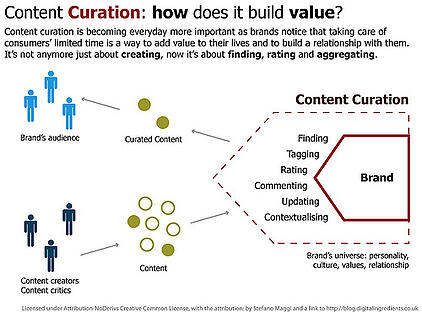While discussing a recent blog post with a colleague it struck me that the notion of content curation has significantly evolved in recent times.
Traditionally the idea has been associated with libraries, archives, galleries, or organisations working with objects or data in some way. For example, the UK’s Digital Curation Centre’s (DCC) have produced a Curation Lifecycle – a complex flow chart capturing the ‘appraise and select’ activities which require information managers to ‘evaluate data and select for long-term curation and preservation’. Therefore it follows that ‘selection’ or ‘acquisition’ is closely linked to library, repository or institutional guidelines on collection development.

The interesting thing is that the term ‘curation’ has become one of the latest buzzwords in the social online sphere, which has been transformed into an activity that is both about marketing and about organisation of the enormous flow of information that is inspired, produced and delivered through social media.
Social networking has definitely become a main outlet for the flow of information. But as FastCompany explain in their article, when an event unfolds in real time, most tweets, for example, go to an unfiltered hashtag that is trending at the time. Trying to absorb and collate this information would be comparable to standing under a waterfall with millions of tweets raining down. Different languages, mostly personal experiences, some from people actually there, authorities, governments, media outlets, fake media outlets…you name it, all producing vast amounts of data. Then someone has to make sense of it all – but if they do, the reward is possibly the most accurate, unbiased real-time account of an event ever likely to be captured.
Mainstream news reporting not only contributes to or makes use of this social news waterfall, but is now also getting involved in curation – because someone has to make sense of the flow of public reporting of events.
So, in the social media sense, content curation is the organising, filtering and ‘making sense of’ information on the Web and sharing the very best pieces of content with your personal or professional network that you’ve cherry picked for them. It comes down to organising your sources, knowing which of them are trustworthy, and, in time, seeing patterns.

For information professionals and librarians it relies on keeping up the pace in adopting these strategies and using tools to publish curated content in the sense of ‘reporting’ what’s happening.
So information professionals now:
- curate their own content for themselves, i.e. have their own repositories with tools like Diigo, Delicious, Evernote, Pinboard, Vodpod, Flickr, RSS readers etc.
- have the ability to share this initial ‘first level’ curation because online tools are socially connected
- go on to curate content for others via targeted tweets or Google+ circles, Facebook pages, Facebook groups, wikis, livebinders, etc.
- and then share this ‘second level’ public curation as a direct extension of the first level of personal curation.
It seems logical then for information professionals to take this one step further and move into a ‘third level’ curation as a form of info-media publishing. Think of this as dynamic content curation that’s about helping keep up with the news, developments, findings, research, etc. Ultimately, the flow of information through social media is changing:
‘While we’re dismantling traditional structures of distribution, we’re also building new forms of information dissemination. Content is no longer being hocked, but links are. People throughout the network are using the attention they receive to traffic in pointers to other content, serving as content mediators. Numerous people have become experts as information networkers.’
Librarians and information professionals can now use all of their social networking resources and return information back to their social network community at the third level of information curation.’
Social content curation is about collecting, organising and sharing information – in a new form, structure or package. Information professionals can become digital curators of information for themselves, and perhaps for others. It will indeed be fascinating to see how this third level curation evolves.
I’m certainly intrigued by the idea of socially connected ways of publishing ‘what’s new’ and ‘what’s newsworthy’ as a different and distinct form of information repository.
(Image Credit: kaboompics via www.pexels.com)


